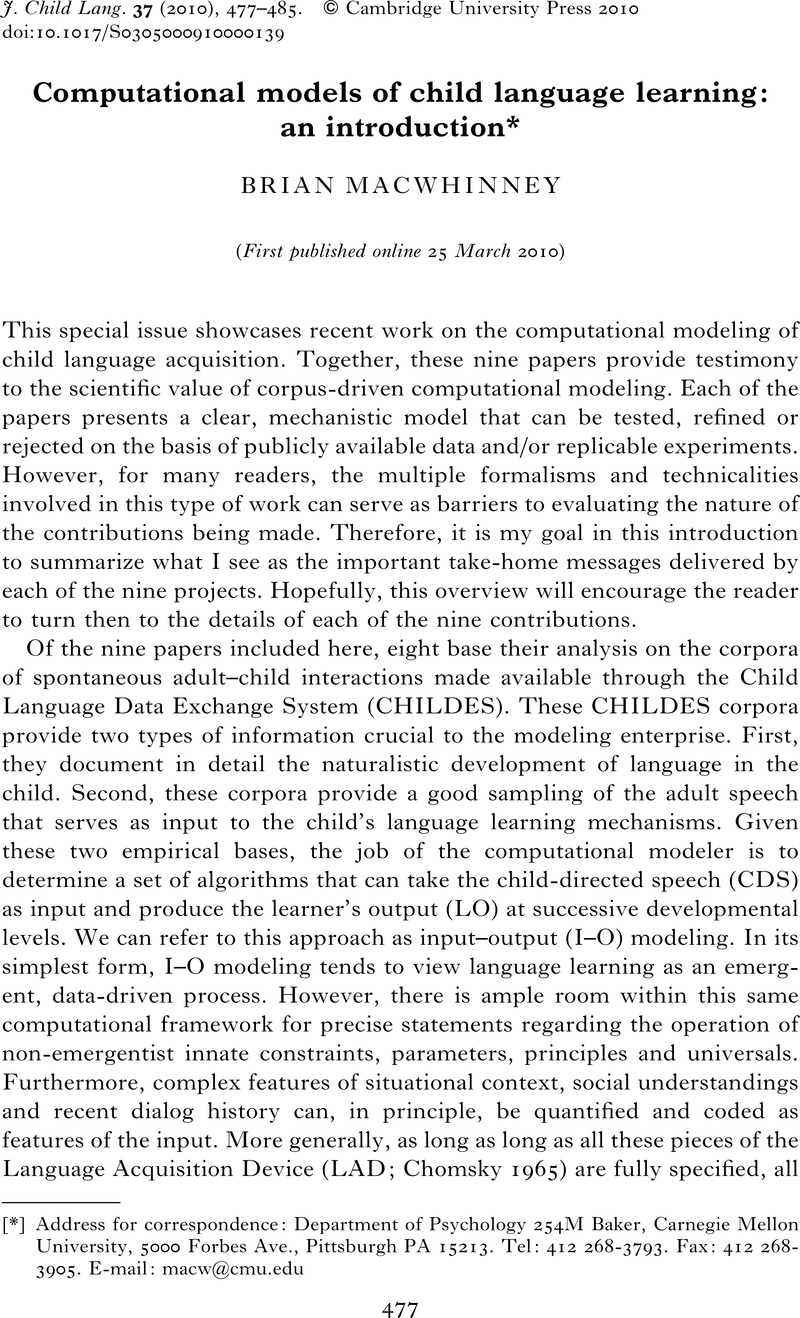Crossref Citations
This article has been cited by the following publications. This list is generated based on data provided by Crossref.
2010.
Computational models of child language learning: an introduction – ERRATUM.
Journal of Child Language,
Vol. 37,
Issue. 4,
p.
963.
Corrigan, Roberta
2011.
Research Methods in Child Language.
p.
271.
Bergmann, Christina
Boves, Lou
and
Bosch, Louis ten
2011.
Measuring word learning performance in computational models and infants.
p.
1.
Tuci, Elio
Ferrauto, Tomassino
Zeschel, Arne
Massera, Gianluca
and
Nolfi, Stefano
2011.
An Experiment on Behavior Generalization and the Emergence of Linguistic Compositionality in Evolving Robots.
IEEE Transactions on Autonomous Mental Development,
Vol. 3,
Issue. 2,
p.
176.
Pezzulo, Giovanni
Baldassarre, Gianluca
Cesta, Amedeo
and
Nolfi, Stefano
2011.
Research on cognitive robotics at the Institute of Cognitive Sciences and Technologies, National Research Council of Italy.
Cognitive Processing,
Vol. 12,
Issue. 4,
p.
367.
Lyon, Caroline
Nehaniv, Chrystopher L.
Saunders, Joe
and
Sporns, Olaf
2012.
Interactive Language Learning by Robots: The Transition from Babbling to Word Forms.
PLoS ONE,
Vol. 7,
Issue. 6,
p.
e38236.
LI, PING
2013.
Computational modeling of bilingualism: How can models tell us more about the bilingual mind?.
Bilingualism: Language and Cognition,
Vol. 16,
Issue. 2,
p.
241.
BEHME, CHRISTINA
2014.
A ‘Galilean’ science of language.
Journal of Linguistics,
Vol. 50,
Issue. 3,
p.
671.
MacWhinney, Brian
2015.
The Handbook of Language Emergence.
p.
1.
Behme, Christina
and
Evans, Vyvyan
2015.
Leaving the myth behind: A reply to.
Lingua,
Vol. 162,
Issue. ,
p.
149.
Arbib, Michael A.
2016.
Primates, computation, and the path to language.
Physics of Life Reviews,
Vol. 16,
Issue. ,
p.
105.
BEHME, CHRISTINA
2016.
Daniel L. Everett, Language: the cultural tool. New York: Pantheon Books. Pp. 351. ISBN 978-0-307-37853-8.
Language and Cognition,
Vol. 8,
Issue. 4,
p.
629.
Arbib, Michael A.
2017.
Toward the Language-Ready Brain: Biological Evolution and Primate Comparisons.
Psychonomic Bulletin & Review,
Vol. 24,
Issue. 1,
p.
142.
Neugebauer, Sabina
Coyne, Michael
McCoach, Betsy
and
Ware, Sharon
2017.
Teaching beyond the intervention: the contribution of teacher language extensions to vocabulary learning in urban kindergarten classrooms.
Reading and Writing,
Vol. 30,
Issue. 3,
p.
543.
Bassani, Hansenclever F.
and
Araujo, Aluizio F.R.
2019.
A neural network architecture for learning word–referent associations in multiple contexts.
Neural Networks,
Vol. 117,
Issue. ,
p.
249.
2022.
Research Methods in Vocabulary Studies.
Vol. 2,
Issue. ,
BENDERS, Titia
and
BLOM, Elma
2023.
Computational modelling of language acquisition: an introduction.
Journal of Child Language,
Vol. 50,
Issue. 6,
p.
1287.
Islam, Elaf
Hain, Thomas
and
Sudro, Protima Nomo
2023.
Simulation of Teacher-Learner Interaction in English Language Pronunciation Learning.
p.
1.
Nixon, Jessie S.
and
Tomaschek, Fabian
2023.
Introduction to the special issue emergence of speech and language from prediction error: error-driven language models.
Language, Cognition and Neuroscience,
Vol. 38,
Issue. 4,
p.
411.
Woensdregt, Marieke
Fusaroli, Riccardo
Rich, Patricia
Modrák, Martin
Kolokolova, Antonina
Wright, Cory
and
Warlaumont, Anne S.
2024.
Lessons for Theory from Scientific Domains Where Evidence is Sparse or Indirect.
Computational Brain & Behavior,
Vol. 7,
Issue. 4,
p.
588.



